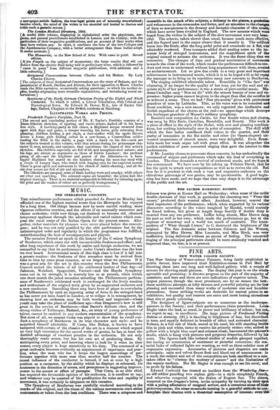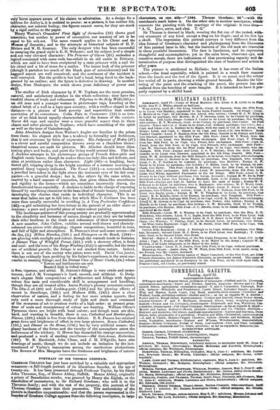FINE ARTS.
NEW WATBR COLOUR SOCIETY.
TAB New Society of Water-colour Painters, being fairly established in public favour, have improved their Exhibition-rooms in Pall Mall by throwing them into one long, and well-lighted- gallery, with a couple off screens for showing small pictures. The display this year is on the-whole. agreeable and promising: it denotes progress on the part of the majority of members; and here and there are seen' indications of superior talent. The largest pictures, though the most prominent, are by zio means the bete: , these ambitious attempts at lofty themes-and powerful painting are far lase pleasing and successful than many works of moderate size and humbler pretensions. Some striking works are desirable for central points in we exhibition; but quality and interest are surer and more lasting attractions than size or gaudy colouring. 7 The designers of figure-subjects are as numerous- as the landscape. - ' painters in this Society; and their performances claim precedence.
'hem takes the lead, as usual, in power and brilliancy of colour' but notnot,,.we regret to say, in excellence. Ells large picture of Firdinand Visiting , Ruben* at Antwerp-, (81,) is dazzling in brightness of hue, but discordant ' in tone, and equally deficient in breadth of effect and animated character. Rubens, in a full suit of black, seated at his easel, his wife standing beside' him in pink and white, turns to receive his princely visitor; who, attired in yellow with a bright blue scarf and crimson cloak, has entered the painter's- studio, which is hung with pictures and gorgeous draperies, followed by his suite. The figureejoek like isolated studies; of models grouped together, but having no communion of sentiment or pictorial connexion: the ma- terial links of reflected lights are wanting, as well as those subtiler ones of responsive expression. Accessories of pictures and draperies are mode ; principals; satin and velvet flaunt flesh and blood out of countenance): in a word, thesubject and art of the composition are both sacrificed to a mis- taken effort to " o'erstep the modesty-of nature" and the limitations of the watery medium. But Mr. Haghe is wise enough to see his error, and to profit by his failure.
Edward Corbould has treated an incident from the Wandering An... an old' soldier guarding two orphan girls—in a style completely French, and otherwise congenial with the fiction of Eugene Sue. The sisters, , mounted on the dragoon's horse, invite sympathy by turning up their eyes with a. poling affectation of resigned sorrow; and, a conscious sense of their , picturesqueness; the vieuz moustache turning in a graceful attitude to con- 'template their charms with a theatrical assumption of interest: even the- vitYliorse-appears aware. of his claims to admiration., As a design for a tableau for Astley's„,it, is entitled to praise; as s picture, it has neither life, character, nor natural feeling; the figures cannot move, for they are stuck by a rigid outline to the paper. Henry Warren's Crusaders' First Sight of Jerusalem (55) shows good intention.' but neither in power of conception nor mastery of art is he equal to his sub, ect. The same. remark applies to his Christ and the' Woman of Samaria ; and to the attempts at historical subjects of H. P. Riviere and. W. H. Kearney. The only designer who has been successful in essaying the grand style is E. H. Wehnert; and his subject is of a simple and. not very elevated character: The Prisoner of Gisors (61) embodies a. legend connected with some rude bas-reliefs in an old castle in Brittany, which are said to have been sculptured by a state prisoner with a nail for his chisel and a bit of stone for a mallet. The intent look of the prisoner (though it partakes too much of the blank gaze of astonishment) and his haggard aspect are well conceived; and the sentiment of the incident is weIrconveyed. But the profile is but half a head, being fixed to the back- pound by an outline; and the figure is defective in drawing. In another design, from Shakspere, the artist shows great deficiency of power and skilL The studies of Irish character by F. W. Topham are the most genuine, natural, and satisfactory sketches in the whole collection: they have the twofold charm of truth and refinement. Pilgrims to the Holy Well (191)— ass :old man and a younger woman in picturesque rags, kneeling at the ruined brink of a well in a bare open country, with a roofless cluipel in the distance—is. a picture of Irish poverty and superstition that carries conviction of its correctness. Cabin Fare in Connemara (12) is an inte- rior of an Irish hovel equally characteristic of the homes of the cottiers. Never did rags and squalor wear a more graceful aspect than in these chaste and sober pictures by Topham; which have something of the spirit ea-well as the tone of Gainsborough.
JOhn Absolon's designs from Walton's Angler are familiar in the prints from them: his elegant style has a tendency to formality and feebleness, that is not overcome by force of expression. His Judgment of Midas (27) is & clever and careful composition thrown away on a thankless theme: theatrical scenes are unfit for pictures. Mr. Absolon should leave illus- trating plays and books, and paint the living world around him. This Jos. J. Jenkins attempts in his picturesque groups of French fisher-girls and English rustic lasses; though he makes them too lady-like and delicate, and aims at prettiriess rather than character. Light (66)—a laughing, bare- footed girl, tripping along in the bright sunshine of a summer morning—is poetical fancy vaguely indientod. The Vaunt (121)—a coxcomb &idling a Jewelled love-token in the light above the downcast eyes of his fair corn- panion--ris a graceful design; but it, like others by the same, artist, is marred by a hard manner of execution, that gives china-like smoothness and rigidity to the forms—which are sometimes incorrectly drawn, the foreshortened faces especially. J. Jenkins is liable to the charge of repeating himself by sacrificing character to his beau ideal of female beauty, instead of developing the charms that reside in individual character. This is an error that ladles are apt to fall into; but which Miss F. Corbaux has been more than usually successful in avoiding_in A Very Particular Coviclence (4a.),-a girl submitting her love-letters to the perusal of an elder sister or mamma: a pure and powerful piece of water-colour painting.
The landscape-painters of this young society are gradually approximating to the simplicity end harmony of nature, though as yet they, are far behind their elder brethren in the truth and refinement of their representations. A new member, John Callow, exhibits several well-drawn and chastely- coloured sea-pieces with shipping: elegant compositions, beautiful in tone and full of light and atmosphere. E. Duncan's river and coast scenes—On
: the Sea, (2,) Milton Marshes, (101,) and Shrimpers on the Benrii (194)— are glowing with sunlight and colour, though the warmth tends to foxiness. A Distant View of WhisifeU Forest, (221,) with a showery effect, is fresh and cool: and the tone of his Sheep-Washing (212) is agreeable, but the_trees are of artificial growth; the foliage is not studied from nature. Indeed, there is not one of the society who paints trees well. David Cox junior, who has evidently been profiting by his father's experience, is.the most suc- cessful in treating foliage; and his Distant View of Hever Castle, (24,) whose
"Towers and battlements one sees Bosom'd high in tufted' trees,"
is flee% vigorous, and aerial. H. Jutsum's foliage is very crude and mono. tenons; and J. M. Youngman's is hard, smooth, and artificial. G. Dodg- sou's elegant little compositions of architecture and foliage with figures evince fine taste and considerable skill in arrangement and handling; though. they are all treated alike. Aaron Penley's gloomy mountain-scenes, The Dhu-14ch (80) and Lochin-y-gairi (129,) and his glowing effects of sunset in Stonehenge, (202,) and .5fideern Hills, (243,) show a close observation of nature, and a feeling. for her more solemn aspects, that only need a more thorough study of light and shade and command of the resources of art to produce works of a high order: at present gran- deur of scale and transparency of colour are wanting. William Oliver's Pyrenean views are bright with local colour; and though most are•thin, hard, and' wanting in breadth, there, is one, Cathedral and Market-place, (220,), which is free from these defects. R. K. Penson has attained great force and brightness of effect in two large pictures, Rouen Cathedral (151,) and Dinant on the Meuse, (I52,) but by very artificial means: the glassy hardness of the forms and the vacuity of the atmosphere attest the hollowness of the trickery. G. Howse has discardethis strange Mannerism, and produced a work of sterling excellence—Old Gate-house, Rotterdam (131). W. N. • Hardwick, John Chase, and J: H. D'Egville, have also drawings of merit; though we do not include an imitation by the last- mentioned of Tarley's mannerism among the meritorious productions. The flowers of Mrs. hiergetts have the freshness and brightness of nature.



























 Previous page
Previous page